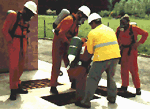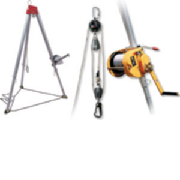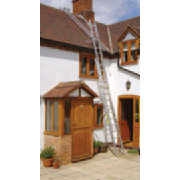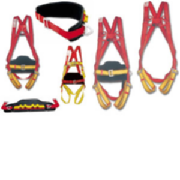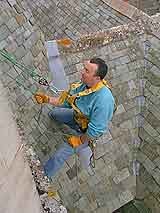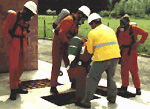CSS Worksafe Ltd
Here at CSS Worksafe, we have been recognised as the leading height safety supplier for over a decade. We specialise in the supply and installation of reliable fall restraint systems and provide expert advice. We provide affordable and safe fall restraint systems suitable for safe guarding your workforce and minimising risk when working at height.
Fall Protection
We provide a variety of fall protection solutions along with service and maintenance of your essential safety equipment. We act as an expert witness for the health and safety executive and design, supply, install test and certify fall protection equipment including:
- Ladder Safety Systems
- Safety Training Courses
- Vertical Safety Systems
- Horizontal Safety Systems
- Fixed Anchorage Points
- Davit Arms
- Eyebolts and Ladder Ties
- Gantry Systems
- Bespoke Solutions i.e. aircraft access (clients include MOD, British Midland, Marshall Aerospace, Virgin Airlines)
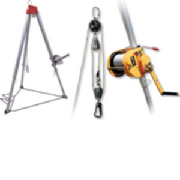
Ladder Safety
As working at height is generally considered to be risky, we have developed and provide a fantastic selection of ladder safety equipment for use by a wide range of tradesmen who work from ladders.
Our ladder safety solutions include safety kits, safety devices, chimney strops and ladder safety training courses suitable for:
- Aerial and Satellite Installation
- Cavity Wall Insulation
- Building and Property Maintenance
- Telegraph Poles and Lighting Columns
- Specialist Applications
- Use of Fall Arrest Systems with Portable Leaning Ladders
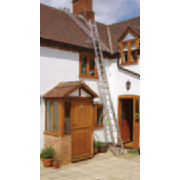
Safety Harnesses
We have an impressive assortment of safety harnesses suitable for use with our safety equipment.
Our high quality safety harnesses and belts include:
- Work Positioning
- Two Point
- Rescue
- Single Point
- Suspension
- Tree Surgery
- Belts
- Restraint
- Multi Task
- Delux
- Budget
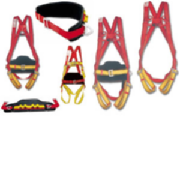
Working at Heights
Falling from heights is one of the most common causes of death on construction sites, but in any type of business, working at height is a high risk activity.
Any work or movement at height near an exposed edge should be considered a hazard and this includes work above or below ground. In order to safeguard your workforce and minimise the risk to those exposed to working at heights the following guidelines should be followed:
- Carry out a risk assessment
- Establish a suitable control method
If you must use a fall arrest or fall restraint system then the following points should be considered.
- Never build your own fall arrest system
- Choose the correct type of anchorage point or restraint system
- Will it take the dynamic loads generated in a fall?
Are there any dangerous obstacles which a person could hit or swing into? - Choose the correct type of equipment
Conforming
Compatible - Check the equipment prior to use for damage
If in doubt seek expert advice or replace it - Train personnel in the correct use of equipment and the procedures that should be followed
- Put in place emergency proceedures
If you are unsure about anything, don’t guess, seek expert advice. You could save yourself a lot of money, time and heartache.
Note the following.
- If a harness and lanyard has been subjected to a fall, they should be disposed of and replaced. The human eye cannot evaluate the stresses that have been put on the equipment and next time they may not work.
- Retractable fall arrest devices, anchorages and systems should be inspected annually or following a fall by a suitably qualified person.
Reducing accidents in the work place is a sound management practice. Not only does it make your workforce happier, but you will save money through improved output and reduce the risk of fines and compensation claims.
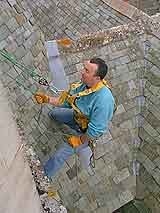
Installed Systems
Installed Fall Arrest Systems, Fall Restraint Systems, Fall Arrest Eyebolts, Guardrail and Access Gantry Systems.
Permanently installed fall protection solutions for all industry sectors.
More often than not the provision of a harness and lanyard is not sufficient to provide workers with the degree of protection required. Without adequate provision for a secure anchorage point operatives remain at risk of falling.
As well as being able to withstand the imposed load of a fall arrest, anchorages should be designed to accommodate the workers task by minimising hindrance to working procedure and movement.
CSS Worksafe offer a range of engineered fall arrest and access solutions that provide workers with continuous fall protection whilst allowing them to carry out their work unrestricted.
These solutions include:
- Horizontal Lifeline Systems
- Vertical Fall Arrest Systems - Fall Protection Systems for Fixed Ladders
- Fixed and Free-standing Handrail Systems
- Gantries & Access Platforms
- Runway Beams
- Fall Arrest Eyebolts
- >>NEW - UniRail™ and Roofsafe™<<
The complete solution
In addition to the provision of equipment CSS Worksafe operate a specialist installation service. As such we are able to provide a turnkey service for specification, design, and installation of solutions to meet clients' access needs.
With ever increasing awareness of therequirement for safe access, building specifiers are designing fall protection systems as standard items on many new structures. CSS Worksafe can meet the supply and installation needs of main contractors sourcing fall protection systems.
Operating as specialist sub-contractors to the construction Industry, CSS Worksafe offer one of the widest ranges of products and services available. From simple eyebolt anchorages to complex lifeline systems, the range of equipment available includes the most advanced systems on the market. CSS Worksafe installation personnel are highly trained safety and access technicians with experience of operating in the most demanding environments.
Confined Spaces
Safe Working in Confined Areas
What is a confined space?
"Confined Space" means any place, including any chamber, tank, vat, silo, pit, trench, pipe, sewer, flue, well, or other similar space in which, by virtue of it’s enclosed nature, there arises a reasonably foreseeable, specified risk.
Many Hazards can exist in a Confined Space, some of which are:
- Flammable Substances and Oxygen Enrichment
- Toxic Gas, Fume or Vapour
- Oxygen Deficiency
- The Ingress or Presence of Liquids
- Solid Material Which Can Flow
- Presence of Excessive Heat
What are your Duties?
Employers and Self Employed persons have a duty to comply with the Confined Space Regulations 1997.
In order to ensure the safety of persons under your control you should:
- Carry Out a Risk Assessment
- Try to Prevent the Need for Entry
- Use a Permit to Work System
- Post Warning Signs
- Establish a Safe Method of Work
- Train Employees
- Provide the Correct Type and Quantity of PPE
- Establish Emergency Procedures
- Follow all Recommended Procedures
Download HSE Booklet 'Safe Work In Confined Places' For More Advice
If you are not confident about any of the above or would just like a second opinion from an expert please do not hesitate to contact us.
Freephone: 0800 783 0757
